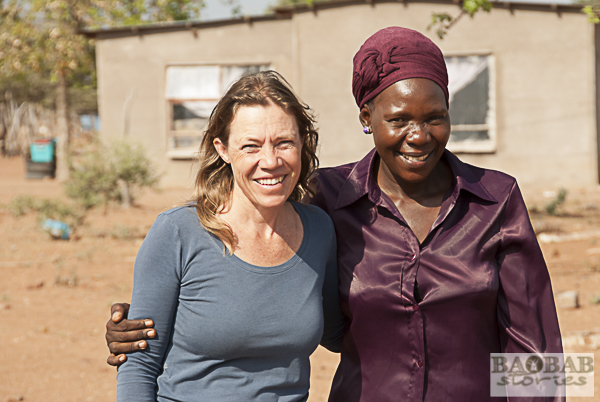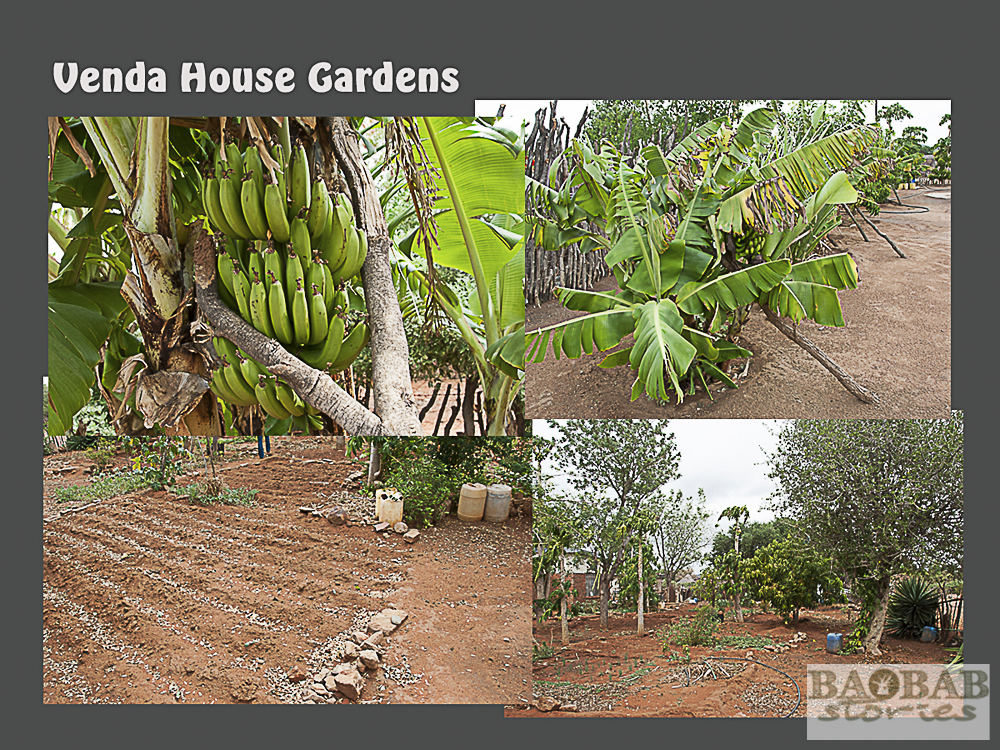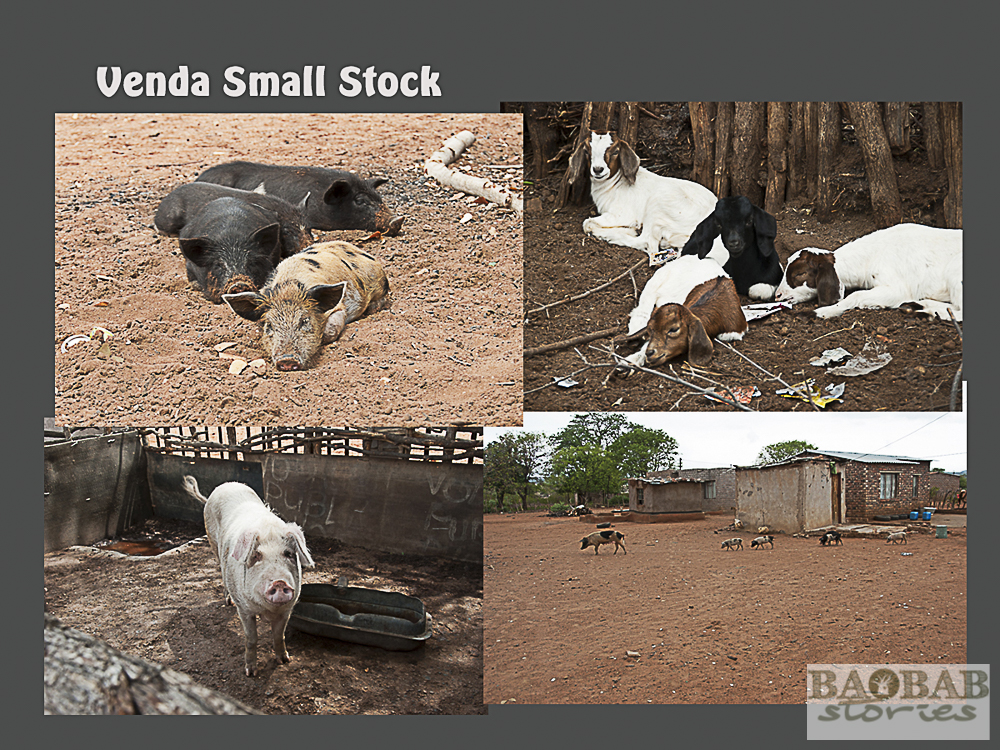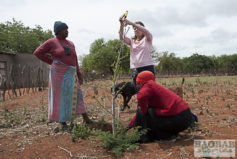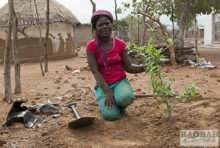We are finally ready: off we go together with Dr. Sarah Venter and Blessing Mamubeda to some villages in the Venda area. We plan to visit Baobab Guardians – women who participate in the Baobab Guardians Programme of the EcoProducts Foundation. The Guardians grow baobab seedlings from seeds and plant them near their homes. They commit themselves to take care of a small baobab for about three years.
Some of the guardians have planted little baobabs in the previous year, others are newcomers. Blessing Mamubeda is the head of the kindergarten in the village Zwigodini. She joins us on our tour to find the individual farms. Although Sarah Venter speaks the local language Tshivenda it is always helpful if someone from the village can accompany us.
Circumstances are Difficult in Venda
It is past midday and the sun burns hot from the sky. The rainy season is overdue. Although we had thunderstorms last night, the amount of rain that came with was not enough. The water has seeped into the sandy ground immediately and the Venda area is groaning under the water shortage.
The humidity is hard to cope with. Our vehicle digs a path through the sandy slope to our first destination. Apart from the one and only tarred road that by accident passes the Sagole Big Tree – no other tarmac roads are found in the area.
The families live on fenced yards. Most keep livestock and care for small vegetable gardens. The houses are simple, usually made of brick. There is no running water. It has to be carried from the only water source in the village. Shopping is almost impossible – those owning cars in this area transport goods from distant cities into the region.
Therefore it is not at all surprising that job opportunities are very scarce here. The women we meet are very grateful for the baobab activities and the incomes Sarah Venter brings to the area.
“We” Plant a Baobab
We arrive in front of the homestead of Martha Kwerana – she expects us and is ready for the activities to come. Proudly, she shows us her small Baobab Collection. Venter seeks out the strongest and tallest plant. The baobab guardian grabs the tree and together we proceed to the place that she has chosen for planting.
The Guardians choose the sites for the baobabs so that they can easily take care of the trees. In the end it is them who have to provide water regularly and protection for the seedlings for at least three years.
The baobabs should not be planted too close to the houses, because they are expected to grow. In the early years they still have taproots reaching deep. Later on that changes. Big trees develop a very strong, shallow and widespread root system that could easily damage the houses.
Recorded via GPS
Hoe, spade and shovel are awaiting us. The sun is intense and heavy on our heads. First signs of sunburn show. With her strong arms the baobab guardian applies the tools courageously to the ground. The hole is dug out quickly. The Baobab waits in its plastic bag that has served as a nursery for months.
She grabs the tree, cuts the plastic off and lifts the baobab with verve into the hole. She is by no means squeamish, fills the hole quickly and presses the soil around the stem firmly. Done.
We proceed to part two: Venter measures the height of the baobab and takes the exact baobab location with her GPS. Then, she copies the figures into a column behind the woman’s name. The latter receives her allowance in South African rand. In a years’ time Venter will return to do a survey on the trees. For every newly grown centimetre the guardian gets a further allowance.
Baobabs grow particularly well in height when they receive water regularly. Growing high is very important for the trees in their first three to five years. In the wild, the little baobabs are exposed to gourmet antelopes, goats and cattle who love to feed on leaves and young baobab shoots.
Some Baobabs refused to Grow
We have now reached the yard of Blessing Mamubeda. What went wrong here with her baobabs remains unclear. She took good care of the small trees. Nevertheless, they have not grown a single centimetre since Venter last measured them.
The ecologist encourages Mamubeda not to give up. The rainy season has just begun and the lack of rain is clearly noticeable in the area. Nevertheless, other baobabs have started sprouting leaves. Perhaps we arrived too early to measure her trees.
Here, Life has its own Pace
We make our way to the next farm on foot – followed by a laughing and screaming crowd of children. With a curiosity so typical for kids of their age they try to fathom what those white people are up to with the little trees.
Do they understand what we are doing? For them, we are a great form of entertainment and distraction from their daily business. They follow us at every step and the little group grows larger, the laughter louder. We enjoy the crowd of kids.
A few piglets have made themselves comfortable in the sand. Chicken cackling, looking for something to eat, their cheeping chicks in tow. We pass gardens, see little goats heavily panting in the shade – due to the heat, and the odd pig peeping curiously from its stable.
Julia Mambeda awaits us. As seen in the other homesteads she has a small baobab collection to choose from. The same procedure is about to repeat itself: Venter seeks the strongest tree, the guardian digs the hole and plants the baobab. The latter is measured, GPS coordinates taken, the results transferred onto the sheet of paper and Mambeda receives her money.
„Baobab Mission accomplished“
At the end of the day we have measured numerous trees and watched how at least 10 new ones were planted – I am tired but our program continues. We proceed to a very special event. The lease for the old kindergarten could not be renewed. Venter managed to collect some funds from her EcoProducts customers for a new place for the kids.
She purchased the building materials on her way to the Venda area, because here they are in short supply. The money that was not spend on the materials is handed over in a ceremony to the committee which will take further steps in the construction of the new kindergarden.
After the “official” part, Venter has a special surprise in store: we drive up to a collection of huge baobabs. There, we will watch how the beautiful flowers of the giants will open up. Read more in the next story to come.

